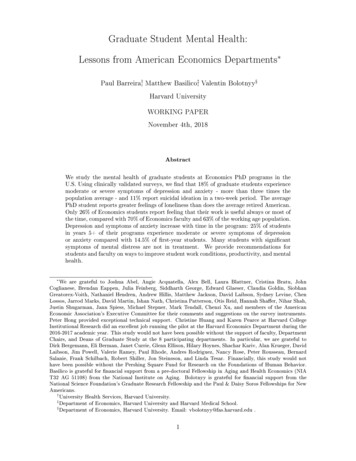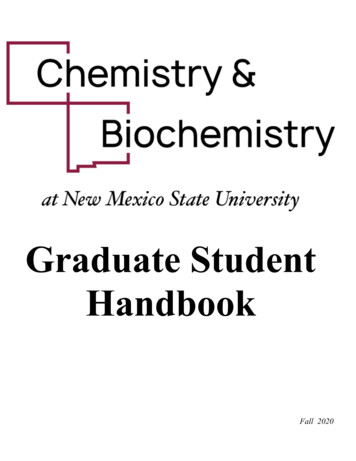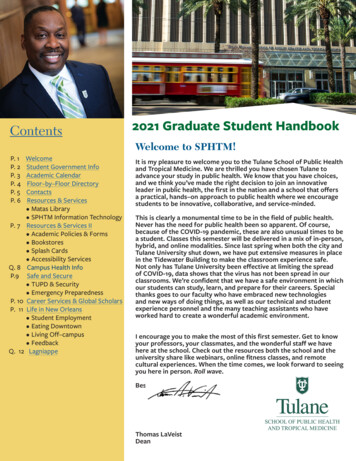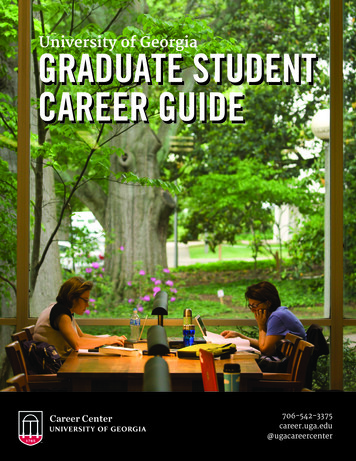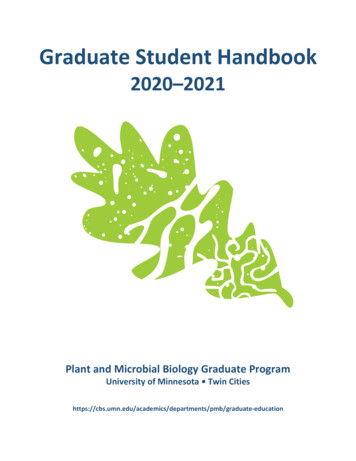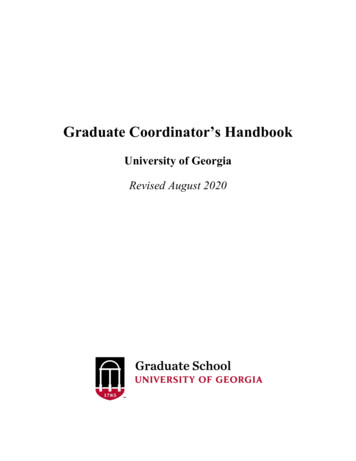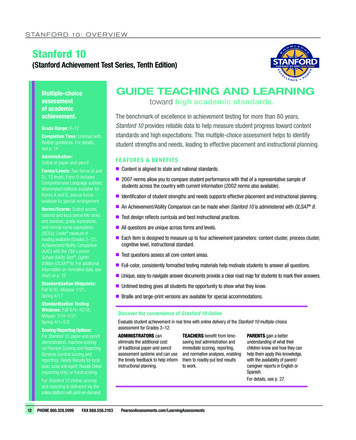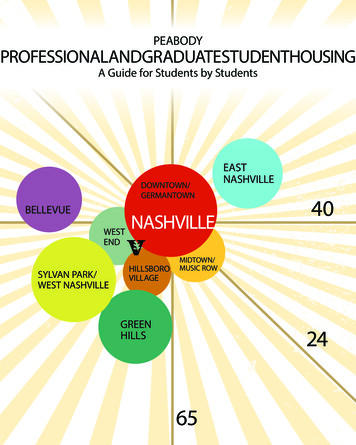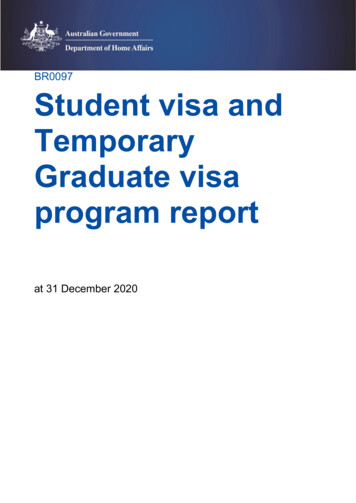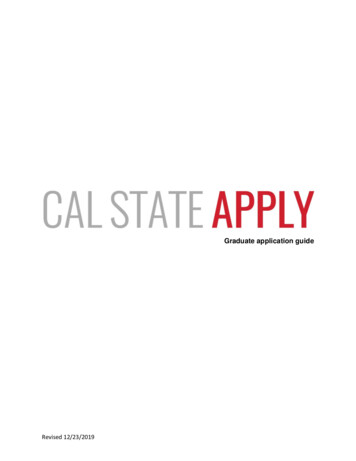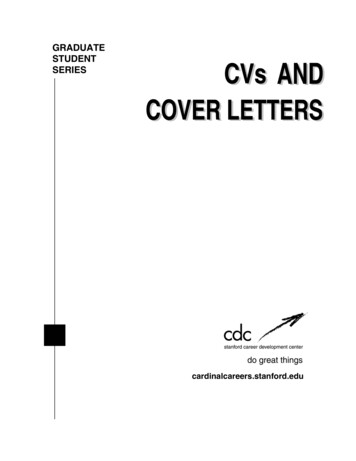
Transcription
GRADUATESTUDENTSERIEScardinalcareers.stanford.edu1
DOCTORAL STUDENTS YEAR OF CANDIDACYGUIDELINES FOR ACADEMIC JOB SEARCHAs you enter your final year of doctoral work many of you may be struggling with the demands ofdefending your dissertation or final research studies, continuing your work as a researchassistant, as well as beginning the process of obtaining an academic job. The following timelineand suggestions may serve as a guide to help you manage your academic job search process.SUMMER QUARTERUpdate your CV, general letter of application and materials for a Teaching Portfolio.Pick up a copy of the CV & COVER LETTER guide from the CDC. Obtain feedback from faculty andfellow students on creating a CV that contains the information for your field of study.Visit CDC and obtain handouts or meet with a counselor to learn about resources that may helpyou in this process.Obtain letters of reference.This is a good time to contact past references and update letters. Consider using the ReferenceFile Service at the CDC to store letters of reference for sFALL QUARTERFinalize one version of your CV as a template – meet with a CDC counselor if needed.You may have various versions of your CV depending on if you are applying for researchpositions, teaching position, endowed chairs, and other types of academic jobs.Apply for positions.Find these through your dissertation chair/advisor, departmental listings, the CDC resources,professional conferences and organizations, and various internet web sites.Continue to solicit letters of recommendation and update previous letters.Attend CDC’s ACADEMIC JOB SEARCH SERIES as well as other departmental and campus events.CV and cover letter writing, Academic Job Talk, on and off campus interviewing are usuallycovered here.WINTER QUARTERContinue applying for positions.Prepare and Practice your academic job talk.Practice interviews with peers, faculty, CDC counselors, and other campus departments andresources.SPRING QUARTERContinue applying for positions.Tenure track and one year positions continue to be announced during this period.Evaluate academic job offers. Be sure to negotiate for time to carefully consider each offer.Discuss negotiation strategies with advisor, CDC counselors, and other personal resources.If you have not found a position to date, do not despair, you may wish to continue applying forjobs. It may take more than one year to find a position.13
For a counseling appointment, please call (650) 723-3963. Also, come by the CDC and pick upadditional guides: THE ACADEMIC JOB SEARCH, INTERNET RESOURCES, COMMUNITY COLLEGE JOBSEARCH, AND TEACHING PORTFOLIOS AND RESEARCH STATEMENTS.INTRODUCTIONThe curriculum vitae (also referred to as the vita or CV) is a summary of an individual’seducational background and experiences. The CV is used when applying for teaching andadministrative positions in academia or for a fellowship or grant. In contrast to a CV, a resume isused to summarize an individual’s education and experience related to a specific career objectivein the private or public sector. The CV is the key document in securing an interview with a searchcommittee. Other important elements of the application process include the application or “cover”letter and letters of reference. In addition, applicants are sometimes asked to include transcripts,teaching evaluations, and research proposals.WRITING YOUR CURRICULUM VITAEIt is crucial to have the CV represent your experience, accomplishments, expertise, and specialprofessional qualities in the most positive manner possible. The visual impact of the CV providesthe initial message about your attention to detail and thoroughness. Is it well designed, organized and attractive?Are categories of information clearly labeled?Is it easy to find certain sections of interest to search committee members?Has your advisor reviewed and critiqued it?Have you avoided using acronyms?Has it been prepared on a computer with letter quality print?Has it been proofread several times to eliminate any typos?Has it been copied on heavyweight, smooth finished white paper?While contents of a CV will vary from field to field, it is worth noting some of the major categoriesand information typically included. Attached are sample resumes which reflect stylisticdifferences and, to some degree, conventions of the fields represented. Your CV should be longenough to thoroughly present all your qualifications in the categories discussed below. That willprobably take two, three, four, or more pages. Typical Format:IDENTIFYING INFORMATION: Name, address, phone, back-up number and email. Leave off dateof birth, marital status, number of children or other information that is not job relatedor does not add to your qualifications.EDUCATION: Begin with your most recent or expected degree. List degrees, majors,institutions, and dates of completion (or expected date) in reverse chronologicalorder. Also list minors, subfields, and honors.DISSERTATION OR THESIS: Provide the title and a brief description of your work, its theoreticalframework, your conclusions, your director (and readers, if their names ordepartments add breadth or new perspectives to your area of research). Forengineering and sciences, if you decide to describe your research more completely inthe “Experience” section, you may want to simply list the title of your dissertation inthis section. For a new candidate in humanities or social sciences, the dissertationshould be featured prominently in this section.AWARDS, HONORS, FELLOWSHIPS, SCHOLARSHIPS: Recognition of scholarship by the universityor within the field is very important. Memberships in honorary societies belong in thissection as well, unless they have already been listed under “Education.”24
PROFESSIONAL EXPERIENCE: This category is often divided into several possible categoriessuch as “Research Experience,” “Consulting,” “Fieldwork,” “Teaching Experience,” or“Postdoctoral Work,” as well as many others, depending on your discipline. Reversechronological order is again the rule.ACADEMIC SERVICE: List all departmental and university groups, committees and task forceson which you served. Student groups are valid as well. You should demonstrate thatyou have exhibited leadership qualities, and you will assume certain departmentaladministrative duties if hired. (See Rivera-Corot CV).MEMBERSHIPS OR PROFESSIONAL AFFILIATIONS: List all professional groups and offices held.LANGUAGES: List all you read/speak and note those in which you are fluent, proficient, or inwhich you have a basic knowledge.DOSSIER OR REFERENCE FILE: Many applicants state that their file is available from the CareerDevelopment Center, Stanford University, 94305-3081, (650) 723-1584. It may beuseful in some disciplines to list your references as well so that they may becontacted by phone.This packet contains samples of application letters (cover letters) which illustrate most of thecrucial information that needs to be communicated when responding to job notices. Usedepartmental letterhead, if appropriate. The most important aspect of your letters is that theyshould be written individually to respond to each position. This means that you must give somethought to how your background matches the qualifications of the position. In addition, yourletters must indicate a sincere interest in academic life and in the institution to which you areapplying.State the specific position for which you are applying and where you learned about it. If there isnot an advertised position, explain who suggested you write or why you are writing. Let thereader know who you are, what your field is, and where you are attending school. Indicate anyspecial interest or background you have that may be of interest to their department or institution.These paragraphs will vary according to your field and possibly the types of positions for whichyou will be applying (teaching emphasis vs. research emphasis). Discuss your dissertation orthesis (or most recent research), what it accomplishes, your methodology, conclusions, and theimplications of your work. This may take more than one paragraph, but you should write to ageneral audience as opposed to specialists in your field. Discuss future plans for research orresearch interest as well. You should also point out supporting fields in which you have expertiseor enumerate the variety of classes you could teach. If the position requires teaching, beenthusiastic about your experience and discuss the courses you have developed or your teachingstyle.Deal with logistics, namely, are you having a reference file sent and a writing sample/chapter ofyour dissertation sent? If so, mention that you look forward to meeting with the committee and totheir inviting you to an interview.35
CATEGORIESAPPROPRIATE FOR THE VITAAcademic PreparationAcademic TrainingEducationEducational BackgroundEducational OverviewProfessional StudiesDegreesPrincipal TeachersInternshipsTeaching/Research AssistantshipsGraduate FieldworkGraduate PracticaProfessional AchievementsCareer AchievementsCareer HighlightsBackgroundThesisMaster’s ProjectComprehensive AreasDissertationDissertation TitlePublicationsScholarly WorksBooksProfessional onsArrangements/ScoresProfessional CompetenciesEducational HighlightsCourse HighlightsProficienciesAreas of KnowledgeAreas of ExpertiseAreas of ExperienceAreas of ConcentrationProfessional ExperienceProfessional OverviewProfessional BackgroundTeaching ExperienceTeaching OverviewExperience SummaryExperience HighlightsResearch ExperienceResearch OverviewAdministrative ExperienceConsulting ExperienceAcademic ServiceProfessional ServiceUniversity InvolvementFaculty LeadershipCommittee LeadershipDepartmental LeadershipProfessional Association Leadershipand ActivitiesScholarly PresentationsConference PresentationsConvention AddressesWorkshop PresentationsWorkshops and ConventionsPrograms and WorkshopsConferences AttendedConference ParticipationConference rshipsScholarly nsureSpecial TrainingEndorsementsTeaching InterestsAcademic InterestsResearch InterestsEducation InterestsProfessional InterestsScholarshipsFellowshipsAcademic AwardsSpecial HonorsDistinctionsCollege DistinctionsHonors and DistinctionsHonors and AwardsPrizesCollege ActivitiesInternational StudyStudy AbroadTravel AbroadLanguagesLanguage CompetencyDossierCredentialsPlacement FileReferencesRecommendationsSource: Finding a Job in Your Field: A Handbook for Ph.D.’s and M.A.’s. R. Anthony & G.Roe. Princeton, NJ: Peterson’s Guides, 1984.46
CURRICULUM VITAE SAMPLES: HUMANITIESp. 12-16SUTHERLAND CV: SLAVIC STUDIESWith this CV, the owner first establishes her academic credentials and the recognition she hasreceived for her research in the form of fellowships. She then balances this with her commitmentto teaching and undergraduate education by giving priority to “Teaching Experience” and“University Service,” placing these sections at the top of the second page where they are sure tobe noticed, rather than putting her publications in this position.Her experience has included living with undergraduates as a Resident Fellow and leadingworkshops on teaching skills for Teaching Assistants. Both are indications of her commitment toundergraduate education and evidence of her teaching skills. She demonstrates her teachingversatility by giving a broad “menu” of “Teaching Interests” and a good listing of graduate levelcourses in language, literature, and linguistics. (Presumably, having had these courses, she cannow teach them.) Since she will be teaching Russian language courses, she has highlighted herlanguage proficiency as well.TAYLOR CV: ENGLISHA very economical CV that tells the reader a great deal about the research interests of the owner,about his significant teaching experience and his impressive honors. The third page gives alisting of graduate courses, which with the teaching experience make the argument that thiscandidate can teach almost anything in modern American literature, African-American literature,literary criticism and can teach a broad range of English literature courses as well. He hastaught both survey/lecture and seminar courses. His two fields of American and AfricanAmerican literature make him especially attractive to hiring committees.He also has managed to be a “good citizen,” giving time to committee service. The indicationsare that he is prepared to be in a setting that, while requiring a full teaching load of undergraduatecourses as a new professor, will reward his research and publication interests.CURRICULUM VITAE SAMPLES: EDUCATIONp. 17-23ROBBINS CV: CURRICULUM AND TEACHER EDUCATIONWhat comes through clearly in this CV is the owner’s commitment to preparing new teachers,improving the teaching strategies of current teachers, and doing research on reading instructionand literacy. All of his “Professional Experience” leads the reader to the conclusion that thiscandidate has defined himself and his field. In this case it works well to have all of theexperience listed in reverse chronological order under one heading. There is often a section of“Research Interests” or “Teaching Interests”, but with this person, his experience, his dissertationtopic, his publication record and his presentations all suggest a research agenda and teachinginterests. This contrasts with the Rivera-Corot CV, in which the owner has several related areasof interest and has organized her extensive and varied experience under several sectionheadings.RIVERA-COROT CV: ADMINISTRATION AND POLICY ANALYSIS - EDUCATIONThis CV portrays the career development of one individual, from student service employee toprogram developer and innovator, to researcher then doctoral student exploring policy questionsabout Chicano/a students and higher education - an ethnic population very under-represented inhigher education. Because of her varied experience and service activities, the variety of researchand evaluation projects already done and the breadth of teaching and research she could do, itseemed wise to organize the CV into categories of information, with descriptive entries for eachjob or project. This emphasizes her capabilities for either an administrative or faculty position, orone that combines both administration and teaching.57
It is much longer than most CVs in humanities, social sciences, natural sciences, or engineering,but the owner has more years of work and education during which she gained experience thatwas appropriate to add to her CV.CURRICULUM VITAE SAMPLES: SCIENCE/ENGINEERINGp. 24-29ARNOLD CV: MATERIALS SCIENCE – ENGINEERINGHere is an illustration of a shorter CV, which focuses on research experience and on articlespublished or accepted for publication. The owner is applying for an academic post-doc and thusemphasizes only research and publications. (His letter of inquiry for a post-doc appears with theother samples of cover letters.)If he were applying for a junior faculty position in a research university, the CV might have someadditions: brief notations about his teaching experience (assuming that he has been a TA atsome point) and a short section on research interests.ALEXANDER CV: CELL BIOLOGY (POST DOC)This candidate is seeking a junior faculty position, with the emphasis on research. For thispurpose, she emphasizes her research experience and makes sure her publications list beginson the first page. Toward the end she gives groups of technical skills to demonstrate herversatility in research and the breadth of techniques she has mastered. With the competition forfunding, she wants to demonstrate that she can carry out research in a number of fields and cantrain and supervise graduate students who might work on a variety of projects.Since she has worked with prominent faculty and they have given their permission to becontacted, she lists them as references at the end. Mark Arnold’s letter, seeking a post-doctoralposition, lists the CDC’s reference file service at the end of his letter instead. You may insteadchoose to include a separate reference page.MARTIN CVS: POPULATION BIOLOGY (POST DOC)This CV emphasizes the writer’s research work, honors, and publications. He can demonstratethat he has been successful in obtaining funding as a student, with several prestigious awardsand a substantial post-doctoral fellowship. Teaching experience is relegated to the second page.With this CV he might send a statement of research interests or brief research proposal, asrequested in some job announcements.WRITING COVER LETTERSAcademic positions usually request cover letters of statements of application from their applicants. Theseprovide you with the opportunity to: initiate contacts personalize your CV provide a brief introduction to your teaching statement/portfolio and research statement respond to job openings focus on your reasons for application to a particular position within a particular institution highlight information that addresses the needs and interests of the employerBear in mind that the letters you write not only convey your interest and qualifications, but also give theemployer an opportunity to observe your attentiveness to detail, spelling, grammar, and the overall quality ofyour written communication. Flaws in letters are often interpreted as flaws in your qualifications.68
We have prepared the following guidelines to help you write cover letters. We have also attached samplecover letters in an attempt to help you compose your own letters. These are not scripts for actual letters,rather, they are simply guides.Informational interview approach letters are sent to contacts, alumni/nae, friends, and referrals asking forinformation, advice, or suggestions. The goal of these letters is to point out your qualifications and obtainmore contacts, not to ask for a job. Always personalize the approach letter by building a connectionbetween yourself and the addressee. Ask for suggestions, information, or request a meeting.Job listing response letters are sent to respond to actual job openings, or to inquire about the possibility ofa job. These letters are appropriate for situations where you know you are a logical candidate for a position,advertised or not.A Good Letter Will:1. Focus on the employer’s needs – not just your own. Ask yourself: “what are they asking for,why do I want this position, and in what ways do I meet their qualifications?” Address these questionsin your letter.2. Be aesthetically pleasing with special attention paid to spacing and format.3. Use business-letter format and be individually typed onto letter quality printer paper or high quality bondpaper that matches your resume paper. Use white or cream colors.4. Generally only be one page.5. Demonstrate your knowledge of the organization.6. Display your professionalism. Avoid bold assertions and egocentric statements, though you should notdisqualify yourself with statements like “Although I have not .” either. Discussion of personal issuesshould be kept at a minimum and do not address salary or visa issues in the cover letter.7. Highlight your skills and abilities and go beyond your resume content. Be clear on your objective andthink about the 2-3 skills that most represent you.8. Ideally be addressed to the hiring manager including a specific individual’s name, title, and organization(all correctly spelled). Use “Dear Human Resources Manager” only as a last resort.9. Show high quality writing and proofing skills. Have someone proofread your letters to avoid errors.Avoid overuse of the pronoun “I” and pay special attention to paragraph transition.10. Address specific skills and interests without being copied verbatim from the attached samples.79
Cover Letter FormatDateStreet AddressCity, State, Zip(Area Code) Phone NumberEmployer’s NameTitleCompany/Organization/InstitutionStreet AddressCity, State, ZipDear Mr./Ms./Dr. :Who are you and what do you want? Your opening paragraph should briefly introduce you andyour interest in the organization or position. If you are aware of a specific position or opening,refer to it now. This paragraph could also mention the name of an individual who recommendedthat you contact the employer, or cite other research that prompted you to write. It is important toindicate why you are interested in their organization.Why are you a good candidate? The middle paragraph(s) should consist of a selection ofhighlights from your background that would be of greatest interest to the organization andconsequently create the “notion of fit.” Focus on your skills and accomplishments and how theycould contribute to the employer. Again, try to display knowledge of the field and organization.Use action verbs to describe relevant skills and expertise and mention specific knowledge youmay have (i.e., lab techniques, computer applications, etc.). A second middle paragraph couldtouch on a particular topic that seems important in the job description that the employerdeveloped. This is one means of separating yourself from all of the other candidates.What will you do next? Your closing paragraph should outline the procedure for action. Statethat you would like to discuss employment opportunities or other information with the person andthat you will call to make arrangements. If you will be in the area, let them know. Thank theaddressees for their time and interest.Sincerely,(Your Signature)Your Typed Nameenclosure(s) (If you send a resume and other materials.)810
Cover Letters OnlineIncreasingly, job seekers are being asked to send their resumes and cover letters online. In terms ofcontent, cover letters are much shorter and more concise. They should address a few key points: How you learned of this positionWhat your objective isWhat qualities you can bring to the organization (you can still use a few key words for which you feelthey are searching)Most experts recommend composing your letters off-line first before “importing” it to an outgoing emailmessage with your resume. Though you can send both documents as attachments, most companies preferthem to be embedded into the body of the email message. You can do this by using your software’s “copyand paste” function. Remember: companies also use key word searches on these documents!Final Tips While a general cover letter allows you to send more letters out and provides a starting foundation, theytend to be more effective when tailored to the specific circumstances (position, organization, etc.)Devise a system to organize your job search materials – especially responses you have received andany follow-ups you have completed. Binders, file folders, or spreadsheets may be effective tools.You may schedule a 15 minute same day or 45 minute appointment with a counselor at the CDC toreview your application materials, proofread your dossier, etc. To schedule an appointment, call 7251789 between 8:15 and 4:30 M-F. Same day appointments are given on a first-come, first-servedbasis, so call early.COVER LETTER SAMPLESP. 30-31* For more examples, see the CV/cover letter binder in the CDC resource library!911
CURRICULUM VITAE EXAMPLEMARY LOU SUTHERLANDDept. of Slavic Languages and LiteraturesStanford UniversityStanford, CA 94305-2006(650) 723-44384433 Oak AvenuePalo Alto, CA 94302(650) sentStanford University, Stanford, CaliforniaPh.D. in Slavic Languages and Literatures (expected, 20XX)19XX-19XXOxford University, Oxford, United KingdomM.Litt in Modern Languages (degreed conferred 19XX)Thesis topic: “The Image of Rural Women in Contemporary Soviet Prose.”19XX-19XXPrinceton University, Princeton, New JerseyB.A. with highest honors in Slavic Languages, June, 19XXThesis topic: The sociology of leisure in the Soviet Union.Certificate with distinction in Russian StudiesCertificate of Study from Leningrad UniversityDISSERTATION“Translating the Russian Narrator into English.” A study of several features of narrative voice, includingskaz and quasi-direct discourse, examining the ways they typically are (or are not) rendered in English.The majority of examples are taken from modern Soviet fiction. Close comparative readings are presentedin light of text linguistics, reader response theory, and general stylistics, with an extended discussion of thehistorical treatment of narrative voice in translation.Advisor: Edward J. BrownReading Committee: Lazar Fleishman, Johanna Nichols, Mary Louise Pratt.ACADEMIC AWARDS20XX-20XX Social Science Research Council Dissertation Fellowship20XX-20XX “New Directions” Mellon Fellowship, Stanford UniversityOffered to a few students each year to encourage “fresh combinations of knowledge andcurricular innovations” in doctoral research.19XX-20XX Stanford Humanities Center Graduate FellowshipAwarded each year to a group of Stanford graduate students, who share the center withfaculty members from various universities, meeting regularly to share research interests intheir respective disciplines.19XX-20XX Department Fellowship, Stanford University19XXFLAS Grant for foreign language study19XX-XXMarshall Scholarship19XXPhi Beta Kappa1012
Page 2RUSSIAN LANGUAGE SKILLSCertified at level 3 (highest level, signifying working professional proficiency) on the ACTFL scale.Trained (but not certified) as a proficiency tester.TEACHING EXPERIENCESTANFORD UNIVERSITY, Stanford, CaliforniaGained experience in developing course content for undergraduate and graduate populations, evaluatingcourse performance, choosing appropriate texts and teaching aides, and holding regular office hours.20XX-20XX First-year Russian (teaching assistant)20XXSurvey of Russian Literature in Translation: The Age of Realism (teaching assistant)19XX-20XX Conversation sections for First-year Russian (course coordinator)19XXRussian Short Stories of 19th Century (in Russian)19XXSeminar on Soviet Culture (guest lecturer on modern Soviet Literature)UNIVERSITY SERVICE19XX-20XX Resident Fellow, Slavic and East European Theme House (“Slavianskii Dom”)Stanford University. Duties include organizing theme-related courses and events, greetingvisiting scholars and dignitaries, advising students and supervising a staff of theme associatesand resident assistants.19XX-19XX Teaching Consultant, Center for Teaching and Learning, Stanford University.Duties included classroom observation, writing a handbook for new teaching assistants, andrunning an orientation workshop.PUBLICATIONS“When Saying was Doing: Speech Acts in the Russian Primary Chronicle.” In Dialogue and CriticalDiscourse. Michael S. Macovski, Editor. Forthcoming from Oxford University Press.Little Jinx (translation of Kroshka tsores by Andrei Siniavsky), with Edward J. Brown, Lawrence Joseph,and Henry Pickford. Forthcoming in Stanford Slavic Studies.“Getting Started: Teaching Tips for Stanford TAs.” Center for Teaching and Learning, StanfordUniversity, 19XX.“Trading Toward Peace: The Case for U.S. - Soviet Commerce,” The Boston Phoenix, December 28,19XX, p. 1 et passim.PAPERS PRESENTED“Narrators with the Common Touch: Translation of Discourse Relations in Soviet Village Prose,” MLAConvention, New Orleans, December 20XX.1113
Page 3“The Narrator and his Grandmother in Soviet Village Prose, “ Stanford Humanities Center, May 20XX.“The Relationship Between the Peasant ‘Baba’ Heroine and Narrator in Village Prose,” AATSEEL AnnualMeeting, San Francisco, December 19XX.RELATED EMPLOYMENT20XX-20XX Translator and editor of manuscripts and private documents for Professor Lazar Fleishman,Stanford University.19XXColegio Los Angelitos/St. George School, Santo Domingo, Dominican Republic.Mathematics Teacher (Grades 8-12)TEACHING INTERESTSRussian Languages - all levelsLiterary TranslationSurvey of Nineteenth-Century ProseProse Fiction of the Soviet PeriodThe Language of Russian LiteratureThe Language of Russian JournalismOld Church SlavicMedieval Russian LiteratureSeminars on major novels such as Dead Souls, The Brothers Karamazov, Crime and Punishment, War andPeace, The Master and Margarita, or Dr. Zhivago, or on works of both historical and literary interest, suchas, The First Circle or Herzen’s My Past and Thoughts.RELEVANT GRADUATE-LEVEL COURSESSLAVIC LANGUAGES & LITERATURESLiterary Translation (seminar)History of RussianHistory of Russian Literary LanguagesOld Russian LiteraturePhonetics and PhonologyComparative Slavic LanguagesNineteenth and Twentieth-Century Prose/PoetryBrothers Karamozov (seminar)Proseminar (literary theory)Old Church SlavicEdward J. BrownRichard SchupbachLazar FleishmanWilliam M. ToddRichard SchupbachJoseph van CampenMonika FrenkelWilliam M. ToddGregory FreidinJoseph van CampenLINGUISTICSLanguage UniversalsSemantics and PragmaticsLanguages in Contact (seminar)Discourse and Interpretation (seminar)Lexical Functional Grammar (seminar, audited)Language, Change (seminar, audited)Situation Semantics (seminar, audited)Charles FergusonEve ClarkJohn RickfordCraige RobertsJoan BresnanPaul KiparskyJohn Barwise & Stanley Peters1214
CURRICULUM VITAE EXAMPLECurtis Allen TaylorHOME: 1000 Paradise LaneOFFICE: Department of EnglishStanford, CA 94305(650) 494-4949cat@stanford.eduEDUCATION:Ph.D. Stanford University, Department of EnglishDegree expected, June 20XXA.B. Harvard University, June 19XXDISSERTATION:“Race, Reenslavement, and Representation:The Troubled Birth of American Realism”Stanford UniversityStanford, CA 94305(650) 725-4494This study discusses the social and racial implications of the campaign for American literary realism during the late 19th century,examining works that range from the novels of W.D. Howells and Henry James to W.E.B. Dubois’s The Philadelphia Negroand The Souls of Black Folk. Dissertation Readers: Professor John Rover (chair), Professor Jane Smith, Profe
CV and cover letter writing, Academic Job Talk, on and off campus interviewing are usually covered here. WINTER QUARTER Continue applying for positions. Prepare and Practice your academic job talk. Practice interviews with peers, faculty, CDC counselors, and other campus departments and r
